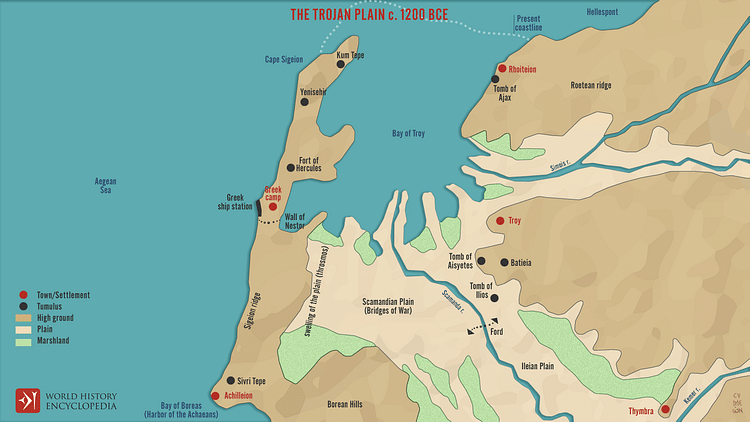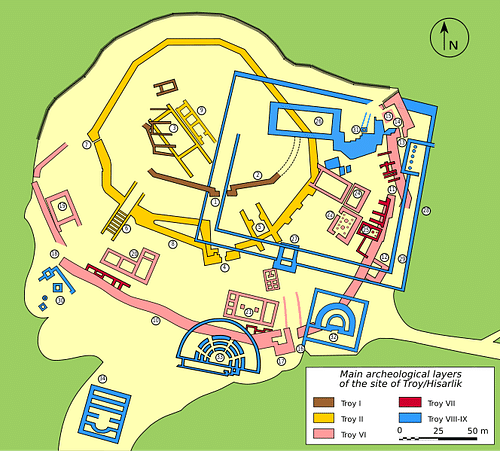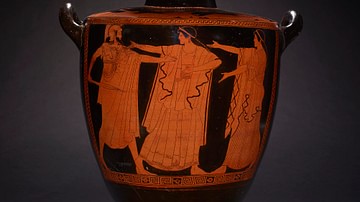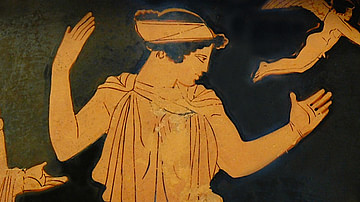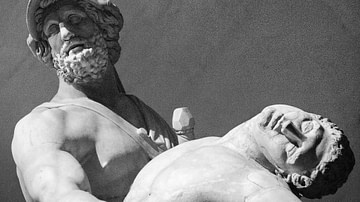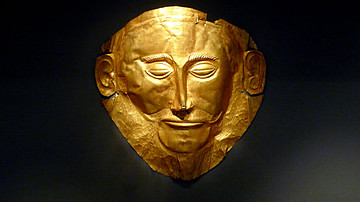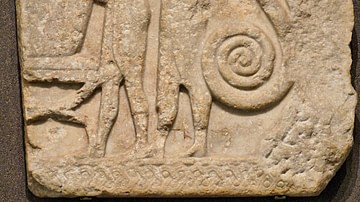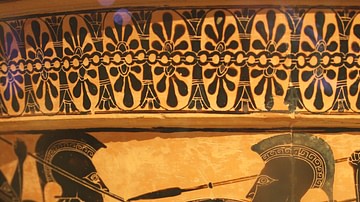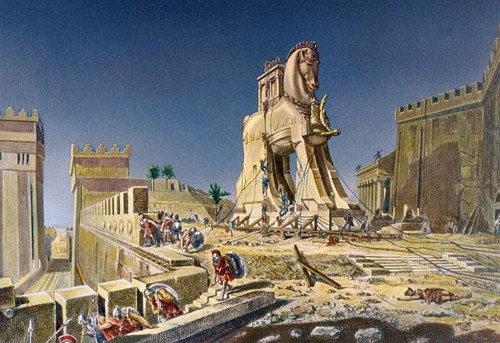
Troy is the name of the Bronze Age city attacked in the Trojan War, a popular story in the mythology of ancient Greece, and the name given to the archaeological site in the north-west of Asia Minor (now Turkey) which has revealed a large and prosperous city occupied over millennia. There has been much scholarly debate as to whether mythical Troy actually existed and if so whether the archaeological site was the same city; however, it is now almost universally accepted that the archaeological excavations have revealed the city of Homer's Iliad. Other names for Troy include Hisarlik (Turkish), Ilios (Homer), Ilion (Greek) and Ilium (Roman). The archaeological site of Troy is listed by UNESCO as a World Heritage Site.
Troy in myth
Troy is the setting for Homer's Iliad in which he recounts the final year of the Trojan War sometime in the 13th century BCE. The war was in fact a ten-year siege of the city by a coalition of Greek forces led by King Agamemnon of Mycenae. The purpose of the expedition was to reclaim Helen, wife of Menelaus, king of Sparta and brother of Agamemnon. Helen was abducted by the Trojan prince Paris and taken as his prize for choosing Aphrodite as the most beautiful goddess in a competition with Athena and Hera. The Trojan War is also told in other sources such as the Epic Cycle poems (of which only fragments survive) and is also briefly mentioned in Homer's Odyssey. Troy and the Trojan War later became a staple myth of Classical Greek and Roman literature.
Homer describes Troy as 'well-founded', 'strong-built' and 'well-walled'; there are also several references to fine battlements, towers and 'high' and 'steep' walls. The walls must have been unusually strong in order to withstand a ten-year siege and in fact, Troy fell through the trickery of the Trojan horse ruse rather than any defensive failing. Indeed, in Greek mythology the walls were so impressive that they were said to have been built by Poseidon and Apollo who after an act of impiety were compelled by Zeus to serve the Trojan king Laomedon for one year. However, the fortifications did not help the king when Hercules sacked the city with an expedition of only six ships. The sacking was Hercules' revenge for not being paid for his services to the king when he killed the sea-serpent sent by Poseidon. This episode was traditionally placed one generation before the Trojan War as the only male survivor was Laomedon's youngest son Priam, the Trojan king in the later conflict.
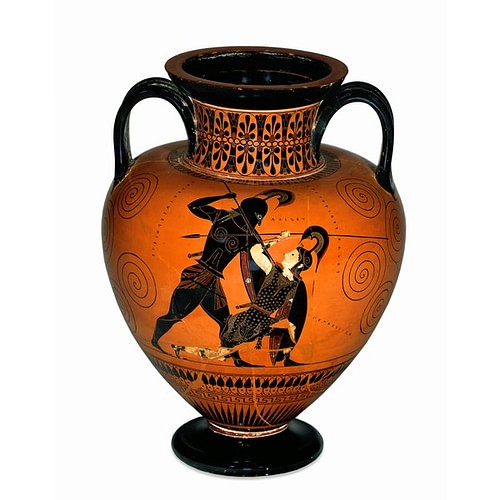
Troy in Archaeology
Inhabited from the Early Bronze Age (3000 BCE) through to the 12th century CE the archaeological site which is now called Troy is 5 km from the coast but was once next to the sea. The site was situated in a bay created by the mouth of the river Skamanda and occupied a strategically important position between Aegean and Eastern civilizations by controlling the principal point of access to the Black Sea, Anatolia and the Balkans from both directions by land and sea. In particular, the difficulty in finding favourable winds to enter the Dardanelles may well have resulted in ancient sailing vessels standing by near Troy. Consequently, the site became the most important Bronze Age city in the North Aegean, reaching the height of its prosperity in the middle Bronze Age, contemporary with the Mycenaean civilization on the Greek mainland and the Hittite empire to the East.
Troy was first excavated by Frank Calvert in 1863 CE and visited by Heinrich Schliemann who continued excavations from 1870 CE until his death in 1890 CE; in particular, he attacked the conspicuous 20 m high artificial mound which had been left untouched since antiquity. Initial finds by Schliemann of gold and silver jewellery and vessels seemed to vindicate his belief that the site was actually the Troy of Homer. However, these have now been dated to more than a thousand years before a probable date for the Trojan War and indicated that the history of the site was much more complex than previously considered. Indeed, perhaps unwittingly, Schliemann would add 2000 years to Western history, which had previously gone back only as far as the first Olympiad of 776 BCE.
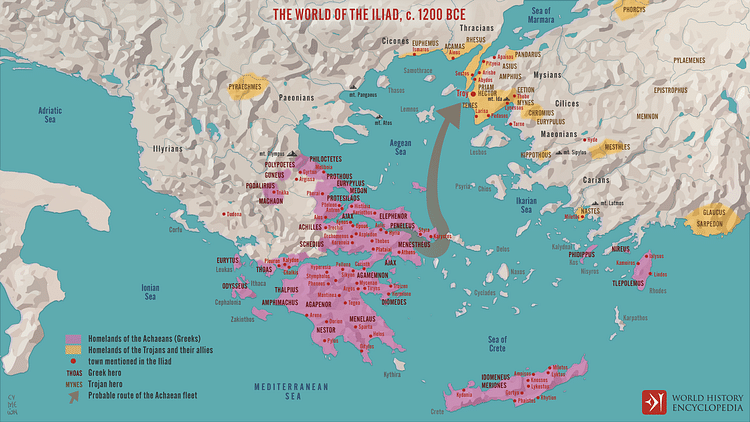
The excavations continued throughout the 20th century CE and continue to the present day and they have revealed nine different cities and no less than 46 levels of inhabitation at the site. These have been labelled Troy I to Troy IX after Schliemann's (and his successor Dorpfeld's) original classification. This has since been slightly adjusted to incorporate radio-carbon dating results from the early 21st century CE.
Troy I (c. 3000-2550 BCE) was a small village settlement surrounded by stone walls. Pottery and metal finds match those on Lesbos and Lemnos in the Aegean and in northern Anatolia.
Troy II (c. 2550-2300 BCE) displays larger buildings (40 m long), mud-brick and stone fortifications with monumental gates. Schliemann's 'treasure' finds - objects in gold, silver, electrum, bronze, carnelian and lapis lazuli - most likely come from this period. This 'treasure' includes 60 earrings, six bracelets, two magnificent diadems and 8750 rings, all in solid gold. Once again, finds of foreign materials suggest trade with Asia.
Troy III - Troy V (c. 2300-1750 BCE) is the most difficult period to reconstruct as the layers were hastily removed in early excavations in order to reach the lower levels. Generally speaking, the period seems a less prosperous one but foreign contact is further evidenced by the presence of Anatolian influenced dome ovens and Minoan pottery.
Troy VI (c. 1750-1300 BCE) is the period most visible today at the site and is the most likely candidate for the besieged city of Homer's Trojan War. Impressive fortification walls 5 m thick and up to 8 m high constructed from large limestone blocks and including several towers (with the rectangular plan as in Hittite fortifications) demonstrate the prosperity but also a concern for defence during this period. The walls would have once been topped by a mud brick and wood superstructure and with closely fitting stonework sloping inwards; as the walls rise they certainly fit the Homeric description of 'strong-built Troy'. In addition, sections of the walls are slightly offset every 10 m or so in order to curve around the site without the necessity for corners (a weak point in wall defence). This feature is unique to Troy and displays an independence from both Mycenaean and Hittite influence. The walls included five gateways allowing entrance to the inner city composed of large structures, once of two stories and with central courts and collonaded halls similar to those of contemporary Mycenaean cities such as Tiryns, Pylos and Mycenae itself. Outside the fortified citadel the lower town covers an impressive 270,000 square metres protected by an encircling rock-cut ditch. The size of the site is now much bigger than first thought when Schliemann excavated and suggests a population of as high as 10,000, much more in keeping with Homer's grand city-state.
Finds at the site point to the existence of a thriving wool industry and the first use of horses, recalling Homer's oft-used epithet 'horse-taming Trojans'. Pottery very similar to that on the Greek mainland has been discovered, principally the Grey Minyan ware which imitates metal vessels. There are also imported ceramics from Crete, Cyprus and the Levant. In marked contrast to Mycenaean palaces, there is no evidence of sculpture or fresco-painted walls.
Troy VI was partially destroyed but the exact cause is not known beyond some evidence of fire. Intriguingly, bronze arrow heads, spear tips and sling shots have been found on the site and even some embedded in the fortification walls, suggesting some sort of conflict. The dates of these (c. 1250 BCE) and the site destruction correlate with Herodotus' dates for the Trojan War. Conflicts over the centuries between Mycenaeans and Hittites are more than probable and may well have been the origin of the epic Trojan War in Greek mythology. There is very little evidence of any large-scale war but the possibility of smaller conflicts is evidenced in Hittite texts where 'Ahhiyawa' is recognised as referring to Mycenaean Greeks and 'Wilusa' as the region of which Ilios was the capital. These documents tell of local unrest and Mycenaean support of local rebellion against Hittite control in the area of Troy and suggest a possible motive for regional rivalry between the two civilizations. Intriguingly, there is also a bronze Mycenaean sword taken as war booty and found in Hattusa, the Hittite capital.
Troy VIIa (c. 1300-1180 BCE) and Troy VIIb (c. 1180-950 BCE) both display an increase in the size of the lower town and some reconstruction of the fortifications but also a marked decline in architectural and artistic quality in respect to Troy VI. For example, there is a return to handmade pottery after centuries of wares made on the wheel. Once again, this correlates well with the Greek tradition that following the Trojan War the city was sacked and abandoned, at least for a time. Both Troy VIIa and Troy VIIb were destroyed by fires.
Troy VIII and Troy IX (c. 950 BCE to 550 CE) are the sites of Greek Ilion and Roman Ilium respectively. There is evidence that the site was populated throughout the so-called Dark Ages but the settlement did not return to a level of significant development until the 8th century BCE. Ancient Troy was never forgotten though. The Persian King Xerxes is said by Herodotus to have sacrificed over a thousand oxen at the site prior to his invasion of Greece and Alexander the Great also visited the site before his expedition in the opposite direction in order to conquer Asia.
A Doric temple to Athena was constructed in the early 3rd century BCE along with new fortifications under Lysimachos (c. 301-280 BCE). The Romans also held Troy in high regard and even referred to the city as 'Sacred Ilium'. In Roman tradition, the Trojan hero Aeneas, son of Venus, had fled Troy and settled in Italy thus giving the Romans a divine ancestry. Julius Caesar in 48 BCE and Emperor Augustus (reign 27 BCE -14 CE) rebuilt much of the city and Hadrian (reign 117-138 CE) also added buildings which included an odeion, gymnasium and baths. Emperor Constantine (reign 324-337 CE) even planned to build his new capital at Troy and some construction work began until Constantinople was chosen instead. Over time the site declined, most probably because the harbour had silted up and the once great city of Troy was finally abandoned, not to be rediscovered for another 1500 years.
